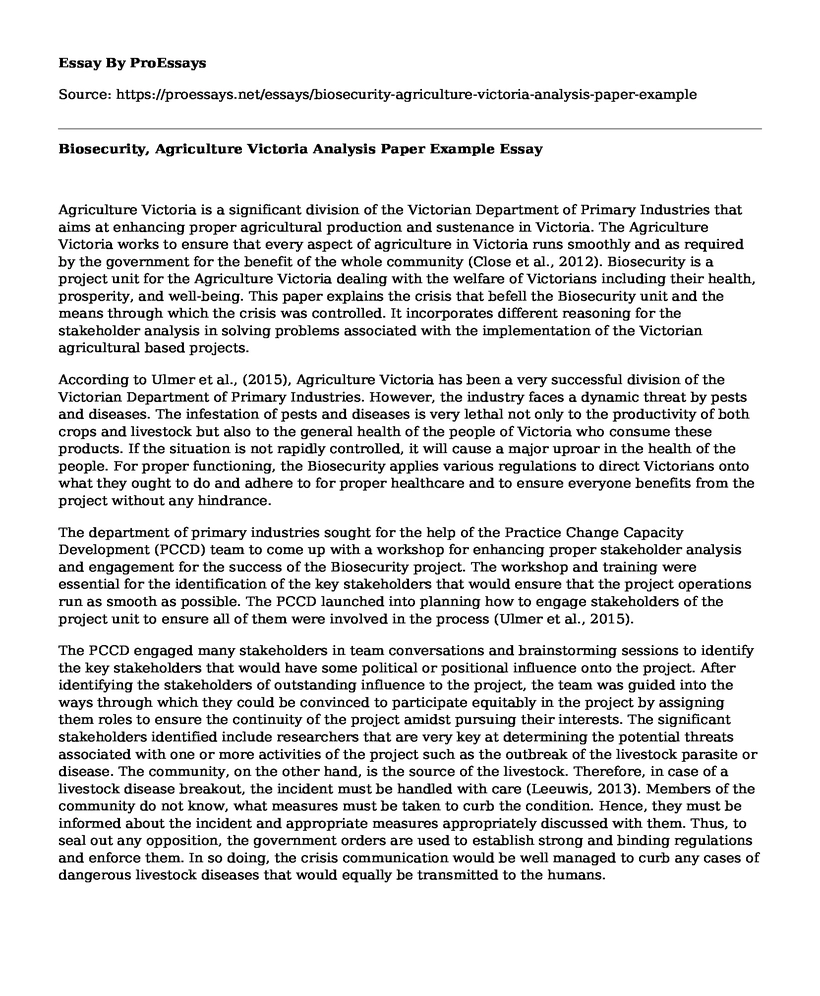Agriculture Victoria is a significant division of the Victorian Department of Primary Industries that aims at enhancing proper agricultural production and sustenance in Victoria. The Agriculture Victoria works to ensure that every aspect of agriculture in Victoria runs smoothly and as required by the government for the benefit of the whole community (Close et al., 2012). Biosecurity is a project unit for the Agriculture Victoria dealing with the welfare of Victorians including their health, prosperity, and well-being. This paper explains the crisis that befell the Biosecurity unit and the means through which the crisis was controlled. It incorporates different reasoning for the stakeholder analysis in solving problems associated with the implementation of the Victorian agricultural based projects.
According to Ulmer et al., (2015), Agriculture Victoria has been a very successful division of the Victorian Department of Primary Industries. However, the industry faces a dynamic threat by pests and diseases. The infestation of pests and diseases is very lethal not only to the productivity of both crops and livestock but also to the general health of the people of Victoria who consume these products. If the situation is not rapidly controlled, it will cause a major uproar in the health of the people. For proper functioning, the Biosecurity applies various regulations to direct Victorians onto what they ought to do and adhere to for proper healthcare and to ensure everyone benefits from the project without any hindrance.
The department of primary industries sought for the help of the Practice Change Capacity Development (PCCD) team to come up with a workshop for enhancing proper stakeholder analysis and engagement for the success of the Biosecurity project. The workshop and training were essential for the identification of the key stakeholders that would ensure that the project operations run as smooth as possible. The PCCD launched into planning how to engage stakeholders of the project unit to ensure all of them were involved in the process (Ulmer et al., 2015).
The PCCD engaged many stakeholders in team conversations and brainstorming sessions to identify the key stakeholders that would have some political or positional influence onto the project. After identifying the stakeholders of outstanding influence to the project, the team was guided into the ways through which they could be convinced to participate equitably in the project by assigning them roles to ensure the continuity of the project amidst pursuing their interests. The significant stakeholders identified include researchers that are very key at determining the potential threats associated with one or more activities of the project such as the outbreak of the livestock parasite or disease. The community, on the other hand, is the source of the livestock. Therefore, in case of a livestock disease breakout, the incident must be handled with care (Leeuwis, 2013). Members of the community do not know, what measures must be taken to curb the condition. Hence, they must be informed about the incident and appropriate measures appropriately discussed with them. Thus, to seal out any opposition, the government orders are used to establish strong and binding regulations and enforce them. In so doing, the crisis communication would be well managed to curb any cases of dangerous livestock diseases that would equally be transmitted to the humans.
Conclusion
In conclusion, the stakeholder analysis is very significant in ensuring the success of every project. The stakeholders are beneficial as both influencers and enhancers of any project implementation process and can significantly determine the fate of the project. It is, therefore, a remarkable opportunity for framing the success and excellence while carrying out projects. When the stakeholder analysis is carried out well, the organization can manage every stage of communication before, during or even after a crisis has occurred.
References
Close, J. E., Burger, S. J., & Berselli, S. J. (2012). Crisis mapping community social media information during and after large-scale disasters in Victoria.
Leeuwis, C. (2013). Communication for rural innovation: rethinking agricultural extension.
John Wiley & Sons.Ulmer, R. R., Sellnow, T. L., & Seeger, M. W. (2015). Effective Crisis Communication: Moving From Crisis to Opportunity (3rd ed.) Thousand Oaks, CA: Sage Publications
Cite this page
Biosecurity, Agriculture Victoria Analysis Paper Example. (2022, Nov 20). Retrieved from https://proessays.net/essays/biosecurity-agriculture-victoria-analysis-paper-example
If you are the original author of this essay and no longer wish to have it published on the ProEssays website, please click below to request its removal:
- Paper Example on International Strategic Management
- Corporate Social Responsibility (CSR) and Business Ethics Essay
- Research Paper on Global Leadership of the 21st Century
- Research Paper on Walmart Inc
- Leadership Style of Jeff Bezos: A Case Study
- Essay Example on VW Group's Steady Rise in Revenue: 252 Billion Euros in 2019
- Wireless Local Area Network: Improving the Value of IT in Daily Lives - Essay Example







